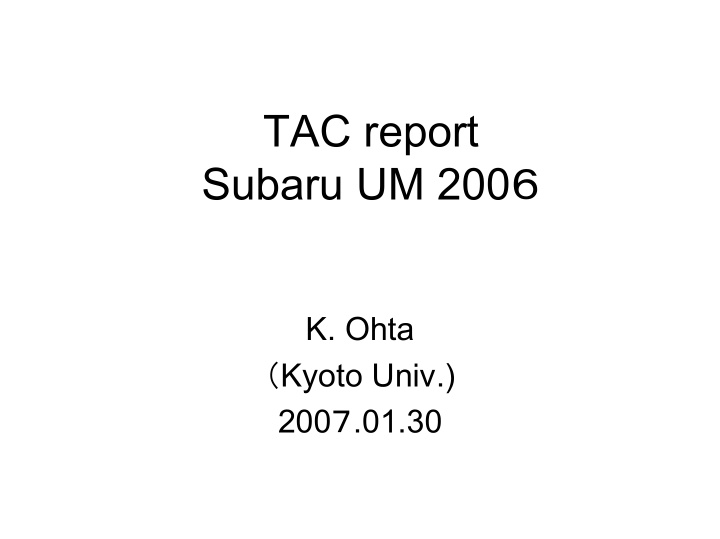



TAC report Subaru UM 200 6 K. Ohta ( Kyoto Univ.) 200 7 .01.30
outline • Trend • TAC members • Process • C2 problem • Enquete report
trends • Number of submitted proposals tends to decrease S04A 164+4 (528/103+5 nights x5.1) S04B 156+4 (533/105+6 nights x5.1) S05A 137+2 (457/84+5 nights x5.4) S05B 113+3 (369/78+3 nights x4.7) S06A 143+2 (474/79+5 nights x6.0) S06B 116+2 (371/88+3 nights x4.2) S07A 123+2 (392/107+1 nights x3.7) • Oversubscription 4-5 • Many nights / proposal • Fixed applicants? • …
4 th TAC members (2005.08-2007.07?) • K. Ohta (Kyoto) chair • S. Sasaki (NAO, Mizusawa) • T. Nakajima (NAO, Mitaka) • M. Hayashi (NAO, Hawaii)=>T. Nagata (Kyoto) • T. Shigeyama (Tokyo) • T. Kodama (NAO, Mitaka) • Y. Yoshii (Tokyo) • M. Chiba (Tohoku) • M. Umemura (Tsukuba )
Process 1 • Category => 8-9 groups each group includes about 20 proposals • A-1 solar system, extra-solar system • B-1 normal star • B-2 star formation, ISM • B-3 compact star, supernova, GRB • C-1 clusters, gravitational lensing • C-2 high-z galaxies, galaxy formation/evolution • C-3 nearby galaxies • C-4 AGNs/QSOs • (C-5 deep surveys, QSO abs lines)
Process 2 • 5 referees for each group • Usually three of them are japanese (staff, PDF) • At least 4 referees review the proposal • 5 -rank relative evaluation + 3 -rank 4 absolute check points • Average calibrated relative score • Comments are strongly recommended
Process 3 • Assign number of nights for each group (Kaken-hi style distribution) • TAC reviews the proposals and approve mainly based on the referees’ score • Considering Min night, challenge, continuation etc • Proposals with the highest-score tend to request many nights , so…
Process 4 • Rough time allocation • Dark in March, April is very compete • Technical comments from SS
Service observations • Reviewed by TAC members (three referees for one proposal) • 3-rank evaluation • Observations are executed based on the scores and obs conditions • After complete your observation, the results are informed to the applicant
C2 problem • Many proposals up to 40 or less • Overlapped fields • TAC needs many referees => very hard to assign referees (refuse, PI/CoIs) • Random assignment to the 7? referees
Summary of the enquete for refereeing 1:proposal • Call for proposal should be earlier than 1 month • Text 2 pages+ figure/table additional 1- 2pages
Summary of the enquete for refereeing 2:process • Min max rejection or 3-sigma rejection 6-7 referees per proposal • Famous(?) users tend to be passed preferentially? • Double blind refereeing • Conservative refereeing => evaluation of referees • Comments to the referee • Referees are poor, selection of referees is poor • Challenging proposals (by TAC or young another TAC) • Open numbers of application in each category(we did it)
Summary of the enquete for refereeing 3:refree’s comments • Referee comments are improved much! (many comments) • TAC comments are poor? • Japanese referees are poor? • Anti-correlation between comment and score
Summary of the enquete for refereeing 4:refree’s comments • Referee comments are improved much! (many comments) • TAC comments are poor? • Japanese referees are poor? • Anti-correlation between comment and score
Recommend
More recommend